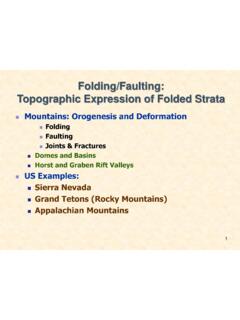Transcription of Fluvial Landforms & Processes - City University of New York
1 Fluvial Landforms & Processes River Systems and Fluvial Landforms Longitudinal Profile and Equilibrium Drainage Basins, classic patterns Lakes and Dams Mountain Streams Straight Rivers Braided Rivers Meandering Rivers Anabranching Rivers Gulleys River Terraces Waterfalls Photo: SCGS. Flood plains Alluvial Fans 1. Fluvial Landforms & Processes Rivers are one of the most dominant agents of landscape change Flowing waters are continually eroding, transporting, and depositing sediments ( Fluvial Processes ). River based flooding is among one of the most frequent and widespread natural hazards. 2. Longitudinal Profile and Watersheds longitudinal profile: an elevation cross-section of the entire watershed from the source of flowing water to the mouth of the stream. headwaters: the highest elevation where water collects to form a stream network. base level: the lowest elevation that a stream can erode its channel.
2 Local or temporary base levels may be formed by reservoirs or waterfalls. Headwaters 3,000. Elevation (feet). Ultimate Base level 0. 100 0. River Length (Miles). 3. Longitudinal Profile and Watersheds A river's gradient (slope) is steepest near the headwaters and gentlest near the mouth. As rivers flow from their headwaters to their base level they carve valleys into the landscape by eroding, transporting, and depositing weathered rocks, soil, and sediment. Headwaters more erosion more 3,000. deposition Elevation (feet). Ultimate Base level 0. 100 0. River Length (Miles). 4. Fluvial Equilibrium Stream gradient is related to water velocity and sediment load A change in any of these affects the other two. base level fluctuations (gradient). precipitation changes (discharge). sediment character Fluvial Equilibrium Recent uplift in excess of erosional rates results in a system that is out of equilibrium.
3 Weathering and erosion dominate headland areas with removed material being transported to a depositional basin. As headlands recede, both erosional and depositional rates decrease. If the region remains stable for an extended period, equilibrium, where erosional and depositional rates are equal, might be achieved: Graded Stream. Fluvial Equilibrium Longitudinal Profile and Watersheds A watershed or basin is the area of land bound by a drainage divide, where all the water within that area drains downstream from its headwaters to a single outflow location. This will include all overland flow, channelized stream flow and any groundwater contribution 8. Longitudinal Profile and Watersheds Drainage divides: high elevation ridges that separate watersheds Valleys: section of the basin with a clearly established drainage system Interfluves: regions separating the valleys, mostly overland flow, no clear drainage pattern established, Nested hierarchy of drainage basins.
4 9. Stream Orders 1. 1. 1 Headwaters: multiple low-order 2 2 1. 3 3. 1 streams near drainage divide 4 4. 5. 5. Base level: single outflow and highest order stream Stream Order: 1st order and 1st order = 2nd order 2nd order and 2nd order = 3rd order 3rd order and 3rd order = 4th order 4th order and 4th order = 5th order 10. And so on, 5 and 5 =6, 6 and 6 =7th order . Mississippi River Drainage Basin 11. Mississippi River Drainage Basin 12. Hudson River Basin Hierarchy of drainage basins USGS: monitoring of major rivers and tributaries falls under USGS jurisdiction. 13. 14. Structural Relationship Consequent Stream: follow the initial slope of the land. Subsequent streams: exploit zones of structural weakness Antecedent Streams: predate geologic activity, was able to down cut and keep pace with the uplift Superimposed stream: initial structure controlling the drainage has been eroded, no resemblance to current surface structure.
5 15. Drainage Patterns 16. Fluvial Erosion 3 distinct categories: Rain splash erosion occurs when the impact of a rain drop loosens and mobilizes particles. Sheet erosion is a process where particles loosened buy rain- splash erosion are transported by runoff water down the slope of a surface. Rill erosion occurs when water concentrates during sheet erosion and erodes small rills or gullys into the surface that channel flow down slope. 17. Copyright Marli Miller Fluvial Erosion Rills & Gullys are the first examples of semi-organized/channelized drainage. When multiple gullys form they produce a disconnected network of headwater channels that dissect the hillslope and increase soil erosion. Gullys are most common on disturbed hillslopes (vegetation free). Erosion-extension typically proceeds upslope Erosion-downcutting: steep gradients, increased flow velocities 18. Fluvial Erosion Rainfall events, melt-water runoff, or ground water percolation.
6 Transported as suspended load, bed load (rolling along the bottom), or bounced by saltation. The accumulation of Fluvial erosion and associated Processes over a large area forms pathways for surface and groundwater flow and carves v-shaped river valleys that continue to erode, transport, and deposit weathered sediments across the landscape. Interlocking Spurs Copyright Marli Miller 19. River Capture or Stream Piracy Abstraction: unequal erosion of a drainage divide, flow transferred to the more energetic side; or Headward Erosion of a tributary Intercision: intersection of meanders or lateral movement of two separate streams Anabranching Systems 20. Upper Course Interlocking Spurs Rapids 21. Upper Course: Mountain Streams high-gradient, low-order, sourced from springs, rainfall, or snowmelt. v-shaped valley, bedrock bottom, rapids, waterfalls, narrow flood plain. contain the largest sediment sizes (boulders, cobbles, gravel, etc.)
7 Localized pools upstream and or downstream of small elevation drops, this pattern is referred to as a step-pool sequence. 22. Upper Course: Waterfalls resistant bedrock, changes in bedrock resistance, fractures or faults. differential weathering creates stair-stepped ledges. less resistant rocks may form pools between waterfalls. faults and fractures provide pathways for the downslope movement of water. knick-point : slowly migrate upstream. This waterfall was formed by differential weathering between the softer shale and harder more resistant Lower White Water Falls in limestone. the Jocassee Gorges area of South Carolina drops nearly 200 ft. Here, the Toxaway Gneiss forms a resistant bedrock that the Lower White Water River flows over before draining into Lake Jocasse. Copyright Marli Miller, University of Oregon Photo: SCGS. 23. Upper Course: Waterfalls 24. Middle Course Alluvial Fans Meanders 25.
8 Middle Course: Alluvial Fans fan-shaped Fluvial deposits that accumulate at the base of stream where it flows out from a steep gradient and enters into a lower- gradient flood plain or valley setting. change in fluid velocity reduces sediment load, forces deposition. common in arid environments with a high sediment load and minimal vegetation. form from a single high-flow event or composite from multiple events. This alluvial fan is carrying a high sediment load from material weathered from the mountains. The dark line along the edge of the fan is a road. Because the road is not buried by recent deposits it suggest that this fan is not currently as active as it was in the past. Copyright Marli Miller, University of Oregon 26. Middle Course: Straight Reach geologically controlled (incised into bedrock, follow geologic structure). not as common as meandering or braided streams associated with higher flow velocities and down cutting of the channel provide insight into bedrock controls or changes in stream gradient Straight reach is incised in limestone bedrock Meandering reach is reworking Straight reach through the flood plain Meandering reach 27.
9 Data source: Middle Course: Meandering lower-gradient, sinuous channels multiple, individual meander bends that laterally migrating across the flood plain. continuously eroding, transporting, and depositing alluvial sediments. variety of depositional and erosional landform features collectively form the flood plain valley. 2006 Aerial imagery: 28. Middle Course: Meandering aggrading pointbar deposit on the inside of a meander bend eroding cut bank along the outside of the bend as the channel migrates laterally across the flood plain, sediments are eroded from the outer cutbank and deposited on the inner pointbar. when meandering channels cut-off entire meander bends oxbow lakes or in-filled channels are formed. 29. Middle Course: Entrenched Meanders Lateral migration is inhibited by geology Down-cutting becomes the dominant erosion mechanism The Colorado River flowing through the Grand Canyon in Arizona, provides a classic example of entrenched meanders.
10 Down cutting began as the Colorado Plateau was uplifted ~5 mya Below are the entrenched meanders of the Colorado River and to the right is the first geologic interpretation of the numerous geologic units exposed by the down cutting river. Courtesy USGS Photographic Library 30. Copyright Michael Collier Lower Course Interlocking Spurs Rapids 31. Lower Course: Braided sediment load exceeds carrying capacity as carrying capacity decreases, sediment is deposited on channel bed river forced to carve new path, creating an interwoven network of channels islands between the braided channels are ephemeral and dynamic sediments are continually remobilized, transported and deposited occur downstream of areas with high sediment loads composition varies from silts, sands, and gravels This is the braided Resurrection River in Alaska. The sediment load consists primarily of silt that has been eroded and weathered from glacial debris.





